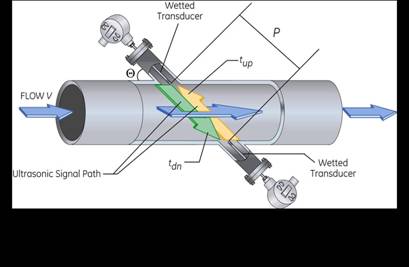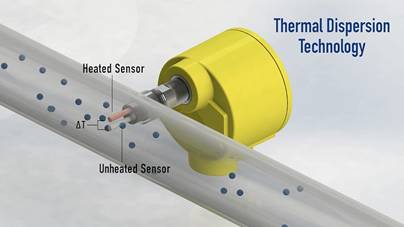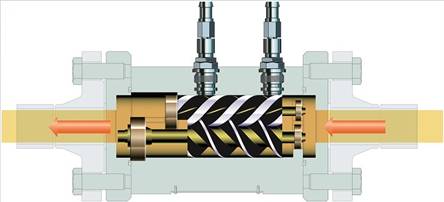|
Flow Research
is now shipping our very popular study, Volume X: The World
Market for Flowmeters, 9th Edition. We have also released the
companion study, Module A: Strategies, Industries, &
Applications. These studies cover the entire worldwide market for all the major types of flowmeters. Module A provides
tactical and strategic recommendations for suppliers in each market segment
and forecasts best areas for future growth. Both are new editions of
studies last published in April 2022..
 Volume X
covers three types of flowmeters: Volume X
covers three types of flowmeters:
New-technology: Coriolis,
magnetic, ultrasonic, vortex, thermal
Conventional: differential
pressure transmitters, primary elements, positive displacement, turbine,
open channel, variable area
Emerging technology: sonar,
optical
The
all-in-one Volume X determines 2022 and 2023 market sizes
and forecasts growth through 2027 for all flowmeters used in process
environments. It makes it easy to compare market size, market shares, and
growth rates for all types of flowmeters. We use a bottom-up method to
determine market size for each flowmeter type, and then put these numbers
together for the worldwide picture. We believe this is the only way to get
a reliable picture of the world flowmeter market and to find out how the
different flowmeter types compare with each other. Volume X features:
-
Market size of the worldwide markets for 11
flowmeter technologies
-
Market size forecasts for each flowmeter type
through 2027
-
Market shares for each flowmeter type
-
Worldwide and regional market size and market
share data
-
A technology description and analysis for each
flowmeter type, including major
competitive strengths and weaknesses
-
Growth factors for each flowmeter technology
-
Company profiles with product information for
easy comparison
Module A covers
Coriolis, magnetic, ultrasonic, vortex, thermal,
differential pressure transmitters, primary elements, positive
displacement, and turbine flowmeters. It provides data about industry
trends and how they are impacting the flowmeter market.
We determined
the largest and fastest-growing industries and applications for each
flowmeter type and forecast the best areas for future growth. We present
the data by each flowmeter type, showing shipments in dollars and
percentages for a long list of industries and applications worldwide
and by region. Module A also includes detailed information
on the major process industries and the applications using flowmeters
today. Module A features:
-
Shipments by industry and application in
dollars and percentages, broken out by flowmeter type
-
Forecasted growth rates by both application
and industry through 2027
-
Essential information on market outlook and
industry trends by flowmeter type
-
Realistic strategies for success for those
entering or already in the flowmeter market
With a base
year of 2022 and reliable data for 2023, we forecast the market by technology to 2027. Flow Research
has definitive data on the flowmeter market going back to 1993. The first
worldwide flowmeter study was published in September 1994 and at that time
the worldwide flowmeter market was just $2.1 billion. Since that time, we
have followed the flowmeter market year by year, beginning with the first
Edition of Volume X published in February 2003. Through eight editions of
Volume X and dozens of studies on individual flowmeter types, we have
chronicled the market as it grew to over three times 1993. Our approach is to
look at each flowmeter type individually and then put all the flowmeter
types together into a definitive analysis of the entire flowmeter market.
This is also the approach we are took in the 9th Edition.
Volume X and
Module A write the definitive story of the effect of the pandemic on the
flowmeter markets. They include 2022 data as a reference point, but
also include actual data and segmentation from 2023 to show what the impact
of the pandemic was on those markets and on the oil & gas industry.
Companies were also asked to project their sales in 2024, and these
responses are taken into account in the forecasting. Forecasts are included
to 2024 that take into account the strong recovery that is already
occurring in the flowmeter markets, and in the economy as a whole. Pent-up
demand helped make 2022 a stronger year for the flowmeter markets, for the
oil & gas industry, and for the economy as a whole. This trend
continued in 2023.
Volume X and Module A display in one glance a comparison
of the revenues, units sold, and compound annual growth rate for all
the main types of flowmeters. Growth factors and limiting factors for
each flowmeter type explain the rationale of the market forecasts and what
can be expected over the next five years. No other studies exist
that provide this type of all-in-one view of the flowmeter market.
The data in
both studies is valuable for any company concerned with developing
strategies and products.. Even companies that sell only one or two types of
flowmeters can benefit from learning about the eight or nine other types of
flowmeters they are competing against.
In our 8th
Edition, we focused on the years 2019, 2020, and 2021. By looking at all
three years we were able to determine the effect of the covid-19 pandemic
for each flowmeter type. In the 9th Edition, we have a base year of 2022
and reliable data for 2023,
and have determined how the market is recovering from the pandemic. In the
9th Edition, we take a completely fresh look at the market for each
flowmeter type, and build this into a definitive picture of the entire
flowmeter market, worldwide and by region.
New-technology flowmeters
Most of the
new-technology flowmeters, came into industrial use in the 1960s and 1970s,
while the history of differential pressure flowmeters goes back to the
early 1900s. Each new-technology flowmeter is based on a different
physical principle and represents a unique approach to flow measurement. Magnetic
flowmeters were first introduced in Holland in 1952. Tokimec first
introduced ultrasonic meters in Japan in 1963. Eastech brought out vortex
flowmeters in 1969, while Coriolis meters came onto the market in 1977.
Thermal flowmeters were developed in the mid-1970s.
 New-technology
flowmeters share several characteristics: New-technology
flowmeters share several characteristics:
1. Introduced after 1950
2. Incorporate technological advances that avoid some of the problems
inherent in earlier flowmeters
3. More the focus of new product development efforts by the major flowmeter
suppliers than traditional technology meters
4. Higher performance level, including criteria such as accuracy, than that
of traditional technology meters
5. Have
limited to no moving parts
Conventional flowmeters
Many of the
conventional flowmeters were developed 100 years or more ago. In fact, the
history of DP meters goes back to the early 1900s, while the beginnings of
the turbine meter go back to at least the late 1700s.
Conventional
flowmeters include differential pressure, turbine, positive displacement,
open channel, and variable area meters. While suppliers continue to bring out enhanced
traditional technology flowmeters, they are less the focus of new product
development than new-technology meters. They share the following
characteristics:
1. Introduced before 1950
2. Less the focus of new product development than new-technology meters
3. Lower accuracy level than new-technology flowmeters
4. Slow to incorporate advances in communication protocols such as HART,
Foundation Fieldbus, and Profibus
5.Typically have moving parts that are subject to wear
Conventional
flowmeters generally have higher maintenance requirements than
new-technology flowmeters. Many of the problems inherent in DP meters are
related to the primary elements they use to measure flow. Orifice plates,
for example, are subject to wear, and can also be knocked out of position
by impurities in the flowstream. Turbine and positive displacement meters
have moving parts that are subject to wear. The accuracy levels of open
channel and variable area meters are significantly lower than
that of new-technology flowmeters.
The battle goes on: New-technology vs. Conventional
flowmeters
One of the
most interesting developments in the flowmeter market today is the battle
between the newer flow technologies and conventional flowmeters. (Emerging technologies, sonar and optical flowmeters have begun to take some
hold on the market, although each has somewhat limited applications.)
 New-technology
flowmeters, first introduced after 1950, are currently the subject of
intense product development by suppliers. The need for increased
accuracy, reliability, and managed network capabilities are causing some
users to make the switch to new-technology meters. New-technology
flowmeters, first introduced after 1950, are currently the subject of
intense product development by suppliers. The need for increased
accuracy, reliability, and managed network capabilities are causing some
users to make the switch to new-technology meters.
Yet
conventional meters -- especially DP flow, positive displacement, and
turbine meters -- have the advantage of a large installed base that is
reluctant to switch without cause. In addition, they were among the first
types of flowmeters to receive approvals from industry associations for
custody transfer applications.
When users
select flowmeters, they are faced with a variety of choices. Not only are
many technologies available, but so are many suppliers for each technology.
When ordering replacement meters, users often replace like with like,
although users sometimes replace one type of flowmeter with another type.
In other cases, users need meters for new plants or for new applications
within existing plants and can select between new-technology and
traditional technology flowmeters.
While there
is a general trend towards new-technology meters and away from conventional
meters, the rate of change varies greatly by industry and application.
Despite the
growth of new-technology flowmeters such as Coriolis and ultrasonic over
the past few years, conventional flowmeters are holding their own. Why are
customers still so loyal to these meters? While the explanations vary with
the type of meter, there are five themes that run throughout:
Familiarity. End-users like having a technology
they are familiar with and can understand. DP, positive displacement, and
turbine meters, especially, are very well known and understood
technologies. There is a comfort level among users with these technologies
that is less likely to exist with the newer technologies such as Coriolis
and vortex. If more meters need to be added in a plant, users often stick
with what they have rather than selecting a different type of meter.
Installed
base. Some flowmeters, such as DP and
positive displacement, have been around for over 100 years. Once these
meters are installed, customers find in many cases that it is easier to
replace them with meters of the same kind than to switch to another
technology. Once a technology is in place, backup parts are readily
available, any potential problems are usually known, and the path for
replacement is clear. All these are reasons to stick with an existing
technology.
 Approvals by standards organizations. For example, positive
displacement and turbine flowmeters are approved by the American Water
Works Association (AWWA) in the US and the International Standards
Organization (ISO) in Europe for use in custody transfer of water. The AWWA
has approvals for both nutating disc and oscillating piston PD meters. Approvals by standards organizations. For example, positive
displacement and turbine flowmeters are approved by the American Water
Works Association (AWWA) in the US and the International Standards
Organization (ISO) in Europe for use in custody transfer of water. The AWWA
has approvals for both nutating disc and oscillating piston PD meters.
The AWWA has
published approvals for magnetic flowmeters for utility measurement of
water. As a result, magnetic flowmeters are competing with PD and turbine
meters in the water custody transfer market.
Turbine
meters are specified by approval bodies for use in custody transfer for
utility measurement in residential, commercial, and industrial
applications. These organizations include the AWWA, the American Gas
Association (AGA), and the ISO in Europe. These approvals have been in
place for many years.
Product
enhancements.. Users are
also sticking with conventional meters because suppliers are bringing
out improved products. Turbine suppliers are using material such as ceramic
to improve the life of ball bearings. Rosemount has introduced the 3051S, a
pressure transmitter with increased accuracy and stability. PD suppliers
are using enhanced manufacturing techniques to build more precision into
their PD meters. Communication protocols such as HART and Profibus are
beginning to appear on turbine and PD meters. All these changes are
resulting in improved and more reliable meters for users to choose from.
Best
solution. Another reason why users continue to
stay with the traditional technologies is that they are genuinely the best
solution for certain types of flow applications. Each type of meter has its
own set of applications in which it excels.
 How we capture the entire flowmeter market at once How we capture the entire flowmeter market at once
It is very
difficult to find reliable data on the entire flowmeter market without
studying each individual technology first and then combining the data
together. Without up-close knowledge of each technology, it would be very
much like viewing a landscape from 20,000 feet. You can see the outlines of
buildings and roads, but very little detail. This may be sufficient
knowledge for some purposes, but not for in-depth understanding.
What we have
done in our popular Volume X is more like the
following: We looked at the terrain from 20,000 feet and decided we needed
a lot more detail on the towns the major flow technologies -- and how
they are linked together with highways. So we landed the plane and did
detailed studies of each of the towns. We then got back in the plane with
the reports in hand, and took another look at the entire geography.
From 20,000
feet, we can now see the broad outline of each of the 11 towns below. But
because we have studied each town individually, we also have in-depth
knowledge of each town. From above, we can also easily see the connecting
roads between all the towns. This is important, because the towns do
not exist in isolation. Anytime a customer selects one type of flowmeter,
he or she fails to select one of the other types. Not every technology can be
growing at a 6 percent rate, for example. By looking at every technology,
it is possible to identify and compare the market penetration of the
different technologies, and to understand which technologies are growing
and which are being replaced.
We draw on
our in-depth studies of each technology to update the most relevant data on
all of the flow technologies at the same time rather than trying to
somehow combine new full-scale studies that would be out of date by the
time the project was done.
Taking this
second look from 20,000 feet -- capturing the very latest high-level
information like revenue, units sold, and average selling price -- gives us
the entire picture, all at one time.
Flow Research
has been publishing Volume X studies since 2003, so we can say
with confidence that our proven approach in the sky and on the
ground -- brings you the most complete, comprehensive, and current research
possible on the world flowmeter market. Please check out our Overview and see for yourself! This
year, 2023 marks the 20th anniversary of our first edition of
this study!
Previous studies:
Volume X: The World Market for
Flowmeters, 8th Edition Published in
April 2022
Volume X: The World Market for
Flowmeters, 7th Edition Published in
May 2019
Volume X: The World Market for
Flowmeters, 6th Edition Published in January 2017
Volume X: The World Market for
Flowmeters, 5th Edition Published in August 2014
Volume X: The World Market for
Flowmeters, 4th Edition Published in 2012
Volume X: The World Market for
Flowmeters, 3rd Edition Published in October 2010
Volume X: The World Market for Flowmeters, 2nd Edition
Published in April 2008
Volume X: The World Market for Flowmeters, 1st Edition
Published in 2003
|